2. Outriggers
Between The Lines - Ch10: Boat Setup
There are many ways to achieve width and height in towing points (i.e. if you are towing the lure with the line going directly from the rod tip then the 'towing point' would be at the rod tip) for trolling such as rod holder and rocket launcher positions as described elsewhere, but none are as effective as using outrigger poles. Outriggers are traditionally a matching pair positioned on the sides of the boat raked at an angle towards the stern of the boat which is angled up when the outriggers are lowered into position. Often there is a third outrigger called the shotgun pole (Fig 1) in the middle of the boat and mounted on the roof, rocket launcher or tower.
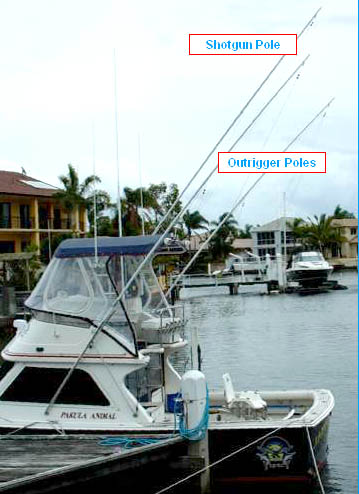 Fig 1
Fig 1
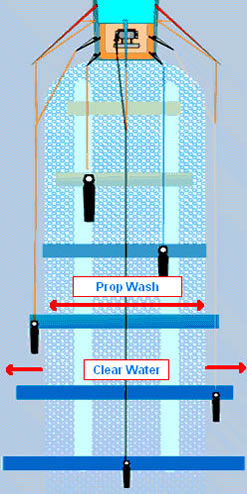 Fig 2
Fig 2
The length of the poles, and their mounting positions, with consideration to their access and angles, should be worked out during practice runs in calm waters as discussed in the previous chapter 'Running Lures'. Unfortunately, it is often the case that the boat has been set-up with holders and riggers mounted before these exercises are done, resulting in a less than optimum configuration. Ideally, the riggers should be set wide enough to place the lures in clear water outside the edge of the prop wash and turbulence. (Fig 2)
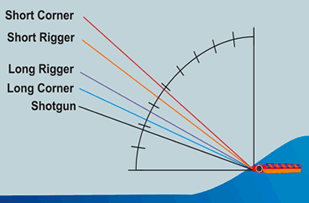 Fig 3The height (Fig 3) of the outrigger tips are set to give the back lures at least as high an angle of entry as the closer lures.
Fig 3The height (Fig 3) of the outrigger tips are set to give the back lures at least as high an angle of entry as the closer lures.
Finally, the rake or angle back towards the stern should put the towing points as far back as possible, with the shotgun positioned slightly higher and further back than the outriggers. (Fig 4) The advantage of having the tow points set back is there is less drop-back or slack line on strike and turning with a full spread out can be at a much sharper angle limiting the possibility of tangles. (Fig 5)
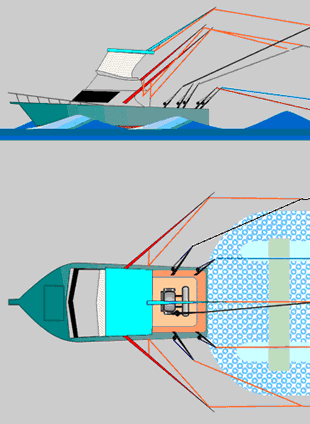 Fig 4
Fig 4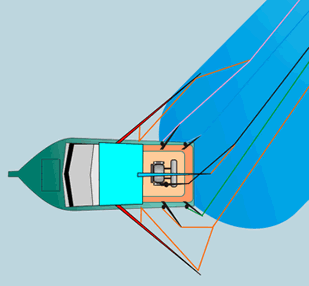 Fig 5The choice of outrigger poles should be based on several factors. All outrigger systems use a form of release. The mechanisms generally either have an adjustment to control the pressure needed to release or in the case of rubber bands, the sizes are chosen for the release and whether a single end or double end is used. This setting can be light enough to just hold the lure in place, releasing the line with the slightest added pressure, or it could be a setting based on your normal strike settings of 33 percent of line class. In the case of heavy tackle, this can put a severe load on the length of an outrigger. In the case of the latter, very strong outrigger poles are needed. In all cases it is an advantage to have poles that are as rigid as possible as flexing poles whip lures out of the water and cushion the line release which drops hook-up ratios. Running a wire stay from the top of the outrigger pole to somewhere forward of the boat, and perhaps a second towards the back of the boat to minimise whip, can compensate to some extent for soft poles and stiffen normal poles. (Fig 6)
Fig 5The choice of outrigger poles should be based on several factors. All outrigger systems use a form of release. The mechanisms generally either have an adjustment to control the pressure needed to release or in the case of rubber bands, the sizes are chosen for the release and whether a single end or double end is used. This setting can be light enough to just hold the lure in place, releasing the line with the slightest added pressure, or it could be a setting based on your normal strike settings of 33 percent of line class. In the case of heavy tackle, this can put a severe load on the length of an outrigger. In the case of the latter, very strong outrigger poles are needed. In all cases it is an advantage to have poles that are as rigid as possible as flexing poles whip lures out of the water and cushion the line release which drops hook-up ratios. Running a wire stay from the top of the outrigger pole to somewhere forward of the boat, and perhaps a second towards the back of the boat to minimise whip, can compensate to some extent for soft poles and stiffen normal poles. (Fig 6)
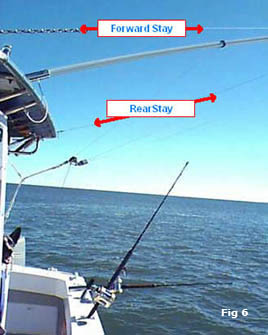
The bases chosen should be strong enough to cope with the severe loads an outrigger can impart. The bases should be mounted using large padding blocks for the bolts and also be mounted where they are easily accessible to raise and lower them.
There are essentially two main release systems used
Light Release and Drop Back System:
Many anglers actually prefer having some drop back which is a length of line that will be deployed with no pressure once a fish has struck. The outriggers are used to control the amount of drop back using any one or a combination of 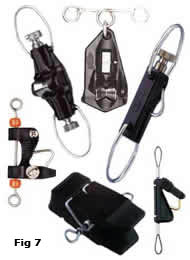 release mechanisms. (Fig 7) There may be added line fed behind the boat to increase the length of the drop back as shown below. In these systems the release is generally as light as possible, only just enough to hold the lure or bait in position. The system, in theory, allows the fish time to turn and swallow the bait before any pressure is applied to hook the fish.
release mechanisms. (Fig 7) There may be added line fed behind the boat to increase the length of the drop back as shown below. In these systems the release is generally as light as possible, only just enough to hold the lure or bait in position. The system, in theory, allows the fish time to turn and swallow the bait before any pressure is applied to hook the fish.
Direct Release
The system involves applying hook-up pressure as soon as possible. Outriggers can have a major drawback. On a strike, you can end up with an awful lot of slack line which might be enough to allow the fish to spit the hooks. Taglines can significantly aid in minimising the amount of drop back. A tagline is merely a length of solid line, one end of which is attached to the outrigger running line. The other end is attached to the trolling line via some form of the release mechanism, such as a rubber band.
There are a great many methods of running lines through outrigger clips, some of which run lines directly through the clips, others use rubber bands on the main line which are then placed in the clip. Others still use loops of either nylon, waxed thread or Dacron loops spliced onto the main line. Despite which mechanism is used, there are several points to note. The clips should be adjusted and checked regularly to the desired release settings using a set of scales. If a line is run to a clip ensure the line is not rubbing on the sides of the rod’s roller tip which may cause a weak spot. Finally, check if a line is running through a release clip that the rod can’t be pulled out of the holder and over the side of the boat.
Using a loop between the clip and the main line is certainly preferable even though running a line through the clip does allow for easy adjustment of lure or bait position and lure retrieval. (Vid 1)
Vid 1
Vid 2





